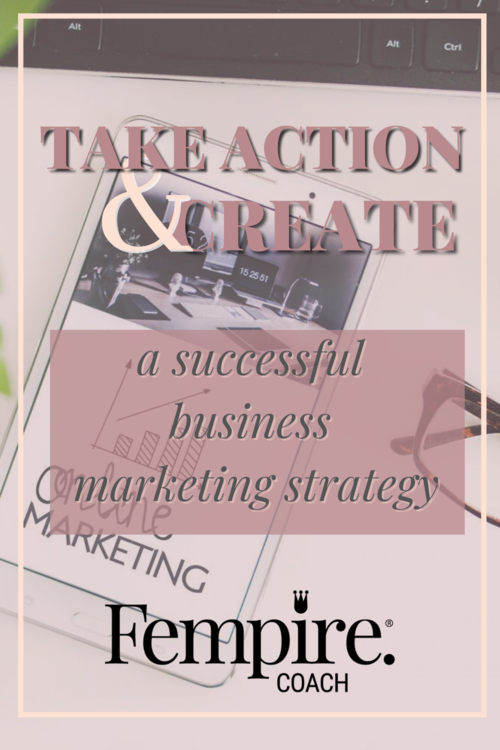
As a powerful woman in business, you already know that strategy and planning are keys to success. But there is more to it than that – you need to take action.
Understand how your strategy will be implemented and more importantly how much time it is going to take, particularly if you are a solopreneur. Time is a commodity that is most in demand and you will be less afraid of failure because you can take the action needed to achieve success.
Whilst there are many tools that will help you save time in actually performing the tasks involved in marketing, these aids are made redundant if you haven’t done the background research and pulled together a marketing strategy.
Without a strategy, you will be essentially posting to social media, or delivering flyers, spending money on ads, or trying different tactics without the framework to assess what will be effective and how you will measure outcomes. Without creating a cohesive, measured, and planned drive with measurable outcomes in mind you will spend more time and money than necessary trying to get results.
So let’s get down to what you need to do to save that precious time.
How do you actually put together a marketing strategy for your business?

1. WHAT are you trying to achieve
First, you need to establish what you want to achieve – set your goals. You may think that marketing is just about getting sales, but that certainly isn’t the entire picture t. Sales are just one part of marketing. You also want marketing to be a part of your customer journey, it creates brand awareness, it is a training tool to educate the market on your product range and how to use them.
2. WHO are you talking to
You need to identify your client’s avatar. Having a clear understanding of who your ideal customer is, what their needs, wants and desires are and how they make their buying decisions is paramount to marketing. This clarity will help you to appeal to the right people.
3. WHY should they listen
In considering any marketing that you produce you need to ask yourself – why is this valuable to my target market? You can start to consider the type of content that would appeal to your audience.
TOUCHPOINT
A TOUCHPOINT is any interaction your business has with your target audience. By interaction I mean any time someone is exposed to your business. This could be through many various ways, some of which include – email, social media, billboard, print advertising, networking and trade events, customer support, invoicing, referral and affiliate marketing, just to name a few.
Your customers require touchpoints and an understanding of how your products can solve their problems. This needs to be communicated in a variety of ways and the messaging needs to be consistent as this will build trust with your audience.There are so many types of content you can choose from. In fact, CoSchedule has compiled a brilliant list of 113 types of content!
4. WHERE do you find customers
Once you select the best content type you need to make sure you also select the right channel in which to deliver this content. These channels could be social media, your website, podcast, youtube channel, signage, flyers, sponsorship, affiliate programs as a couple of examples. You can also make your life easier by moulding content into different formats to capitalize on multiple streams, for example a Youtube video could be transcribed as a blog for your website and cut into bite sized portions for Instagram. This is called CONTENT MULTIPLICATION.
5. WHEN is the best time to communicate
The final piece of your strategy is timing the release of your marketing. Consideration of things such as seasons, holidays, product release dates, anything that might be happening that affects your customers – can and should all be planned as much as possible. If you do a little research or have hired a social media manager to create a strategy, you should also have access to peak times for your customers on whichever social media platform you’re using.
Strategy and Action are the lock and the key – one is pointless without the other.
Put Your Strategy into Action
Now that you have created a marketing strategy, let’s talk about execution. The beauty of having a strategy is that it allows you to create a process for the creation and delivery of all the elements of your marketing. Many businesses will include content creation as a part of their marketing strategy and this is where planning can really save you time and money. As part of the Fempreneur course we step you through identifying 100 content topics. If you understand how to leverage content then this list will keep you busy for well over a year – how amazing is that?!

So the time saving comes firstly from being organised. Knowing what you need to create means that you avoid spending time conducting research into what you think people might be interested in whilst you’re already in create mode – and trust me that can be like going down a rabbit hole. You can certainly end up more confused about what content to produce than when you opened your web browser 6 hours ago.
Multitasking – Stop telling yourself you are getting more done.

Let’s segue here and talk multitasking. I used to pride myself on my ability to multitask. Mobile phone in one hand, baby on my hip, using my toes to pick up a dummy and the other leg to hold down paperwork – all while doing the invoicing. Ok so maybe that is a bit of an exaggeration but you get the idea.
I would scurry around the house with a pot of spaghetti on the boil, washing in the machine, computer connecting to the internet (back in the days of ADSL, domestos in the toilet – thinking I was amazing because I was getting all these jobs done AT THE SAME TIME! I am a MACHINE. No I wasn’t.
What I learned was that the pot would boil over and that meant cleaning the cooktop, the internet would time out waiting for me so I would have to start the connection process again, and so it goes on. I was actually creating more work for myself. It isn’t just me either, Stanford University did studies that showed that people like me were in fact worse than I thought at multitasking and slower at switching from one task to another.
Scientists mapped brains and discovered that we are in fact overloading our brains when we multitask because we are forcing them into overload by our constant switching. So what has this got to do with your marketing strategy? I am trying to stop you from winging it, and trying to get you to appreciate just how important focus, clarity, and a proper plan is.
The Key to Streamlining Processes – Online Tools and Applications
Once you have your strategy mapped out, it is a good time to then review the tools that you will need to streamline your processes (and just make things easier). Let me share how I do things – my blog writing for instance.
Create a Content Plan – Google Sheets

I use a google sheet to create my content plan. I like to do this so I have everything laid out in front of me like a map. I can see all the moving parts and how the content flows on from one week to the next.
Manage the Workflow – Trello
I then create a card in Trello for each idea I have and set a due date on it as per my content plan.
Create the Content – Google Docs
I create written content using google docs, these are nice and easy to attach to the trello card. It also makes it easy for my team to do their part – but if you are working alone by setting a due date in Trello you are just giving yourself that bit of accountability.
Create Graphics – Canva
I use Canva to create graphic elements, infographics, social posts – it is an amazing design tool for people like me that just love the creative process but aren’t necessarily artistic.
Publish on Website – Squarespace
Then I upload what I create into my website and into Content Studio – my social media scheduling app.
Of course these are just some of the available tools and apps you can use in your business. There are many more.
Now while this might sound like a lot of moving parts, but it isn’t that scary.
Everything in Trello, Canva and Squarespace is created using a template. I set this up once and can then just recreate the same standard of work every single time.
The other key tool I use is my Google Calendar. I block out time in my calendar to batch my work. It gives me focus time, I work on writing blogs and creating graphics at the time of day when I am most effective, and I am NOT multitasking.
Many of these apps or their competitors will get you started with a free version. This is great when you are starting out. Of course once you are running a more established business you will want to consider the increased functionality that a paid version can provide when it’s financially viable for you.
A Strategy needs to be reviewed and updated regularly
Any marketing strategy you develop will need to be reviewed periodically and assessed against the goals that you set. With the rapid advances in technology and changes in the marketplace you will want to make sure that your plan is still relevant and delivering the outcomes you aimed for.
Overall, by planning and executing your strategy, you should deliver great outcomes or learning. Developing a strategy sounds overwhelming but it can be quite simple. In fact simple is better because you have an increased chance of following through.
Best of luck, and I am always available for a free 30-minute initial consult, absolutely obligation-free.

